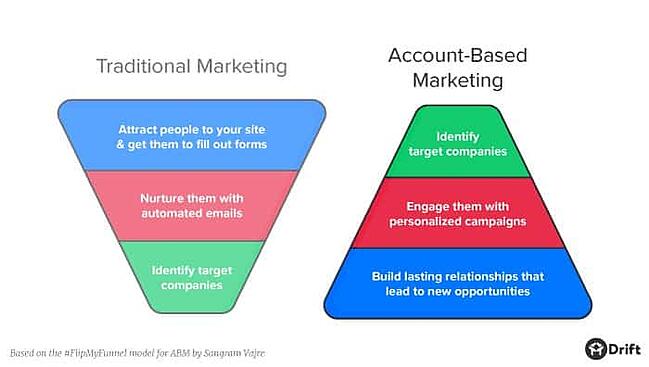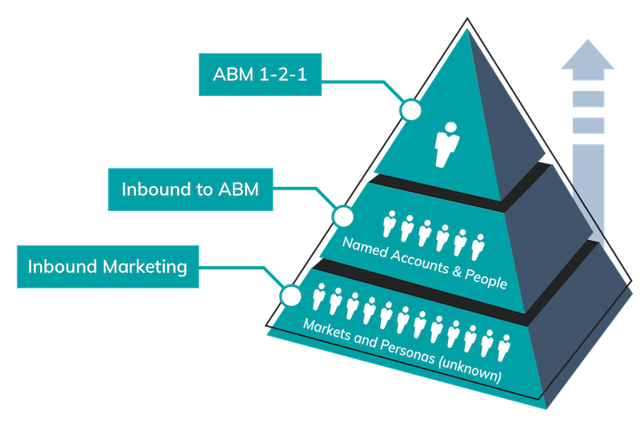Does ABM Work? The Astounding Truth With Case Study

Inbound marketing is considered golden when it comes to generating leads for stable conversion, but those efforts alone cannot secure exponential growth. While inbound marketing may be a significant growth tool, according to ABM experts, account-based marketing is the secret weapon that helps accelerate your flywheel.
While inbound marketing efforts allow you to capture leads with the creation of content that attracts and converts customers, it is a passive tactic that can leave your sales dwindling at the baseline. On the other hand, account-based marketing (ABM) is highly targeted. The focused growth strategy allows you to capture larger leads through a personalized experience.
As amazing as this may sound, those who contest ABM argue that the quality of leads —not the quantity— is the primary concern of integrating this methodology into B2B marketing efforts. Below we illustrate some examples of successful ABM integrations and examine how this approach can either make or break your top-line growth.

Aligning Sales and Marketing to Drive Account-Based Marketing Results
The common misconception of account-based marketing is that it’s a lead generation tool that utilizes personal marketing campaigns. To achieve success with this marketing model, you must understand that ABM is not a campaign or monthly initiative — it is a relationship-building tool, uses personalized experiences, that can only be effective when Sales and Marketing work together to drive results.
ABM perfectly compliments the account-based approach that sales teams embrace, while simultaneously providing the approach needed for marketing teams to directly impact revenue. It is perfect for building cohesion and autonomy as well as growth. In order for this to be achieved, Sales and Marketing must align to mutually establish account scopes, targets, and metrics on how and when to move new relationships down the pipeline.
This means that ABM works by providing increased efficiency and is the go-to strategy for shortening sales cycles, increasing ROI, and effectively selling to higher quality leads — despite what some may say.

A Better Methodology For ABM Success
Account-based marketing begins with segmentation, or selecting the appropriate accounts, and matching them with the correct marketing programs and messaging.
According to Optimizely, a leading experience optimization platform, your approach to targeting a specific account will depend on the particular attributes of that account, the meaningful segment for that account, and its relevant marketing channels.
For example, in-person events are one of the most successful opportunities for sales teams to persuade decision-makers. So, an ABM approach to events would include personal invitations from marketing to key prospects from the account and a personal follow-up after the event. Depending on the company’s policy, VIP dinners and personalized gifts may also be an option.
In addition to the example above, ABM can be successful when utilizing social networking or an email approach with a personalized, tailored effort to make a connection. Email blasts from CRMs and marketing systems do not work with account-based marketing, this is why it’s important to use the correct ABM platform.

Insights From An ABM Case Study
As part of our inbound marketing efforts, we here at Chatter Buzz drove leads through both Google Search and Facebook campaigns. Rarely did we look to Twitter or LinkedIn for any sort of marketing efforts.
While we were satisfied with the above-average performance on our lead generation KPIs, scaling our paid campaigns to increase revenue wasn’t an option. This need for growth encouraged our move into an ABM approach and we shifted our budget accordingly.
ABM Campaign Details:
● Roll Works was selected as the ABM platform.
● The first campaign was launched without salesforce integrations due to timing.
● A/B tests were added 4 months after the initial campaign.
● Nearly 150 campaigns were launched over 8 months.
● Campaigns were split between massive target account lists (TALs) and smaller CRM/TAL lists.
With the collaboration between our marketing and sales team, results proved to be favorable. As you will see from the below results, even smaller campaigns were worth the time and money.
A/B Upsell Test Details:
● Scope: Within the A/B Test, a list of upsell accounts were selected. To further test, half the accounts were included in the campaign while the others were excluded.
● Spend: $100k – 94% of the spend went to prospecting campaigns and the remaining 6% was allocated for retargeting across 10 campaigns.
● Sales Results: Compared to the control group, Chatter Buzz saw a 32% increase in sales contact activities for accounts that were part of the ABM campaign.
Campaign Results:
● Reach: 91% of TAL (roughly 700) saw at least 1 ad.
● Site Visits: Of the 91% reached, 67% visited one landing page which resulted in nearly 4k unique visitors.
● Engagement: 62% visited at least 3 landing pages.
Our tests proved that ABM was able to drive significantly more qualified leads. We also discovered that native ads drove more traffic at 0.32% compared to web display ads at 0.19%. Results were similar or better for our additional National Brand Awareness and Regional campaigns.
Regional Campaign Details:
● Scope: Targeted a very specific TAL in one state. The accounts had previously signed up for a pilot, so this was effectively “stage two” of the campaign.
● Campaign Results: 20% win rate with over half a million in revenue.
The Regional campaigns provided one of the highest results at a percentage of the cost and size, proving that even a modest budget can impact sales results.
National Brand Awareness Campaign Details (Current Customers):
● Scope: This was purely aimed at improving current customers’ product knowledge.
● Spend: $250k – 77% dedicated to web account targeting and 23% to native/social CRM targeting.
Campaign Results:
● 17.5 million impressions, 74k clicks
● Site Visits: 55k unique, 17k engaged
● Reach: 90% of TAL (roughly 400) saw at least 1 ad
● Engagement: 75% visited at least 3 landing pages
Though the National Brand Awareness campaign was a large investment for a non-sales-focused campaign, we learned that we could leverage an ABM platform to target the primary users much more effectively than the traditional PPC platforms we had previously run on, as well as other non-paid campaigns.
Overall Impacts of ABM Marketing Efforts
With the shift from traditional, inbound marketing is a requirement for any business on- or offline. However, though inbound marketing can bring in qualified leads, account-based marketing has proved to be the approach that solicits greater results on sales growth.
The scalability of ABM in comparison to other marketing options is almost undeniable across all ad campaigns. Since implementing ABM practices, we’ve seen a drop in cost-based marketing metrics including an 80% CPM reduction and an 86% lower CPC since moving digital ad spend over to an account-based marketing strategy.








